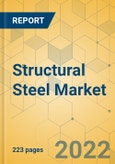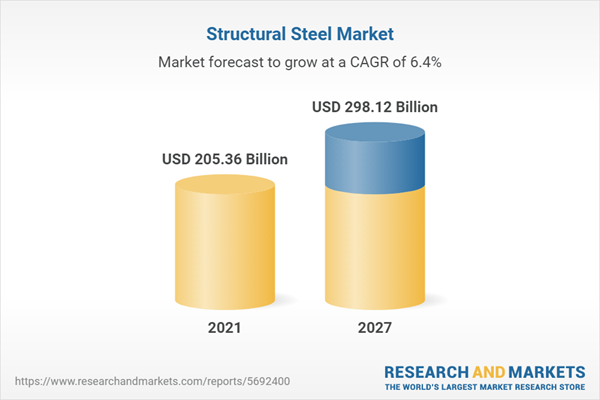Speak directly to the analyst to clarify any post sales queries you may have.
Structural steel is also used in various industries such as power generation, electricity transmission & distribution, mining, etc. Most of the substructure components in the mines are supported by structural steel beams and columns. Structural steel is used to construct all workshops, offices, and mine structural sections such as mining screens, fluidized bed boilers, and structures. Structural steels are often specified by industry or national standards such as the American Society for Testing and Materials (ASTM), British Standards Institution (BSI), International Standards Organisation (ISO), and so on. In most situations, standards specify fundamental requirements, such as chemical composition, tensile strength, and load-carrying capacity.
Many standards across the world specify structural steel forms. In brief, standards specify angles, tolerances, dimensions, and cross-sectional measurements of steel called structural steel. Many sections are manufactured by hot or cold rolling, while others are formed by welding flat or curved plates together. The structural steel beams and columns are connected by using welding or bolts. Steel structures are widely used in the construction of industrial sheds due to their ability to withstand enormous loads and vibrations.
Additionally, ships, submarines, supertankers, ladders, steel floors and grating, steps, and manufactured steel pieces are examples of maritime vehicles that use structural steel. Structural steel can withstand external pressures and is quickly produced. These characteristics make structural steel suitable for use in the naval industry. Therefore, many structures that support the marine industry, such as docs and ports, use a wide range of steel structures.
MARKET TRENDS & OPPORTUNITIES
Growing Market of Light Gauge Steel Framing
- Light gauge steel frame (LGSF) structure is a new-generation construction technology widely used in residential and commercial construction in the structural steel market. This technology uses cold-formed steel. Generally, a light gauge steel frame is applied for roof systems, wall systems, roof panels, floor systems, decks, and the entire building. Designing LGSF structures offers great flexibility in the design. Compared to conventional RCC and wooden structures, the LGSF can be used for long distances, providing flexibility in design. Using steel in construction permits designers and architects to design freely by taking advantage of the high strength of steel. This flexibility of LGSF offers a large floor area compared to RCC structures. The LGSF technology is cost-effective for constructing residential and commercial buildings; therefore, the demand for LGSF structures is expected to grow in emerging economies due to the low disposable income of people.
Growing Demand for Sustainable Construction Materials
- The demand for sustainable construction materials is increasing rapidly in the global structural steel market as these materials are environmentally friendly and help the construction industry to practice sustainable development. Structural steel is one of the sustainable construction materials for the construction industry that has been used in many buildings and industrial shed projects. Structural steel is widely used in industrial sheds; structural steel components get damaged because of continuous wear and tear due to various manufacturing activities. Therefore, structural steel components are regularly replaced and repaired to maintain structural integrity. Structural steel is a highly recyclable construction material that is generally used in industrial sheds and some residential structures. Additionally, structural steel buildings' life is more than regular bricks and concrete structures. Steel structures take less time to construct, and the wastage of materials is less due to the pre-engineered nature of construction.
INDUSTRY CHALLENGES
Expensive Maintenance
- The maintenance cost of structural steel buildings is higher than conventional buildings. For example, if the steel column gets damaged, you need to replace the whole column, but for conventional columns, there are some procedures to repair that damage. Similarly, steel structures need anti-rusting coating and paint more often to prevent steel structures rust. These anti-rust coats and paints increase the maintenance cost for steel structures; thereby, the expensive maintenance causes a hindrance to the growth of the structural steel market.
SEGMENTATION ANALYSIS
INSIGHTS BY APPLICATION
The structural steel market is segmented into infrastructure, industrial, commercial, and residential under the application segment. Infrastructure is expected to be the largest application segment in the structural steel market. It is expected to grow at a CAGR of 6.65% during the forecast period. Structural steel is utilized in various infrastructures, including trains, bridges, towers, tunnels, airports, ports, electricity grids, and other constructions. In recent years, the demand for the infrastructure sector is expected to grow significantly due to rapid industrial development and increasing population. Therefore, the demand for structural steel for the infrastructure segment is also projected to grow. Governments and developers use structural steel for infrastructure projects because of its cost, time efficiency, and sustainable properties. Infrastructure development is critical for a country's economic success; thus, governments invest heavily in infrastructure projects such as trains, roads, electricity, water, and sanitation.Segmentation by Application
- Infrastructure
- Industrial
- Commercial
- Residential
INSIGHTS BY TYPE
Hot rolled steel is the largest segment amongst others in the structural steel market and is expected to reach 235.29 billion by 2027. Hot rolled steel is widely used in structural steel construction. Hot-rolled steel is more accessible to manufacture than cold-rolled steel, and the cost of manufacturing is also lower than cold-rolled steel.Therefore, many contractors, architects, and building designers are using hot-rolled steel, which saves significant money in building construction. Hot rolled steel utilizes compressive forming processes such as rolling, metal extrusion, forging, etc. Because metal can be formed at high temperatures without additional delays, it can be produced in more significant quantities than cold-rolled steel.
Segmentation by Type
- Hot-Rolled Steel
- Cold-Rolled Steel
GEOGRAPHICAL ANALYSIS
The global structural steel market has many established companies operating in major parts of the world. APAC is one of the largest structural steel markets, growing with a CAGR of 6.68%. The growth is attributed to the infrastructure and industrial development in this region increasing rapidly due to the high population, abundant availability of raw materials, friendly government policies, increased FDI, and availability of skilled and unskilled labor. Asia Pacific region is home to various developing countries such as India, China, South Korea, and Indonesia. Governments of these developing countries have come up with monetary and fiscal policies attracting investment in industrial and infrastructure activities and boosting economic development. Similarly, the growing population is strengthening the commercial and residential sectors due to growing economic activities.Even though APAC is a dominant market in the world, many other countries with high scope of development in structural steel will challenge APAC's dominance. Regions such as North America and Europe have the most developed countries with well-established industries that require significant infrastructure to support the daily operations of various sectors. Additionally, the growing awareness of sustainable development in developed countries is expected to boost the structural steel market in North America and Europe.
Segmentation by Geography
- North America
- U.S.
- Canada
- Europe
- Russia
- Germany
- Itay
- France
- Spain
- U.K.
- Rest of Europe
- APAC
- China
- India
- Japan
- South Korea
- Rest of APAC
- Middle East & Africa
- UAE
- Saudi Arabia
- South Africa
- Rest of MEA
- Latin America
- Brazil
- Mexico
- Rest of Latin America
VENDOR LANDSCAPE
The major players in the structural steel market have formed strategic partnerships with various building and industrial shed construction companies and the various industries that use structural steel. This gives companies a competitive advantage that boosts their market share. The key companies have developed aftermarket services that create value for their customers. Companies in the structural steel industry compete strategically. The growth in sustainable processes and initiatives has challenged all companies globally. Investments in R&D, technological advancement, and environmental and economic challenges drive the demand for innovative and sustainable structural steel products.Some key players in the global structural steel market include ArcelorMittal (Luxembourg), Tata Steel (India), Nippon (Japan), Hyundai Steel (South Korea), and Shougang (China). These players have adopted strategies such as expansion, acquisitions, new product development, joint ventures, and others to increase their revenues in the structural steel market. Furthermore, other prominent companies such as Anyang Iron & Steel Group (China), British Steel (UK), Emirates Steel (UAE), Evraz (UK), and others have invested significant capital in R&D to develop structural steel products that will appeal to the customers. Therefore, these other prominent companies are giving tough competition to major companies.
Key Vendors
- ArcelorMittal
- Nippon Steel Corporation
- Shougang
- TATA Steel
- Hyundai Steel
Other Vendors
- Anyang Iron & Steel Group Co., Ltd.
- British Steel
- China Ansteel Group Corporation Limited
- Emirates Steel
- Evraz PLC
- Gerdau S/A
- HBIS Group Co., Ltd
- JSW Steel
- Nucor
- POSCO
- SSAB
- Steel Authority of India Limited (SAIL)
- Tangshan Jun Nan Trade Company Limited
- Voestalpine AG
KEY QUESTIONS ANSWERED
1. How big is the structural steel market?2. What is the projected market size of the global structural steel market by 2027?
3. What is the growth rate of the global structural steel market?
4. Which region dominates the global structural steel market?
5. What are the primary trends in the structural steel market?
6. Who are the key players in the global structural steel market?
Table of Contents
Companies Mentioned
- ArcelorMittal
- Nippon Steel Corporation
- Shougang
- TATA Steel
- Hyundai Steel
- Anyang Iron & Steel Group Co., Ltd.
- British Steel
- China Ansteel Group Corporation Limited
- Emirates Steel
- Evraz PLC
- Gerdau S/A
- HBIS Group Co., Ltd
- JSW Steel
- Nucor
- POSCO
- SSAB
- Steel Authority of India Limited (SAIL)
- Tangshan Jun Nan Trade Company Limited
- Voestalpine AG
Methodology
Our research comprises a mix of primary and secondary research. The secondary research sources that are typically referred to include, but are not limited to, company websites, annual reports, financial reports, company pipeline charts, broker reports, investor presentations and SEC filings, journals and conferences, internal proprietary databases, news articles, press releases, and webcasts specific to the companies operating in any given market.
Primary research involves email interactions with the industry participants across major geographies. The participants who typically take part in such a process include, but are not limited to, CEOs, VPs, business development managers, market intelligence managers, and national sales managers. We primarily rely on internal research work and internal databases that we have populated over the years. We cross-verify our secondary research findings with the primary respondents participating in the study.

LOADING...
Table Information
| Report Attribute | Details |
|---|---|
| No. of Pages | 223 |
| Published | November 2022 |
| Forecast Period | 2021 - 2027 |
| Estimated Market Value ( USD | $ 205.36 Billion |
| Forecasted Market Value ( USD | $ 298.12 Billion |
| Compound Annual Growth Rate | 6.4% |
| Regions Covered | Global |
| No. of Companies Mentioned | 19 |









